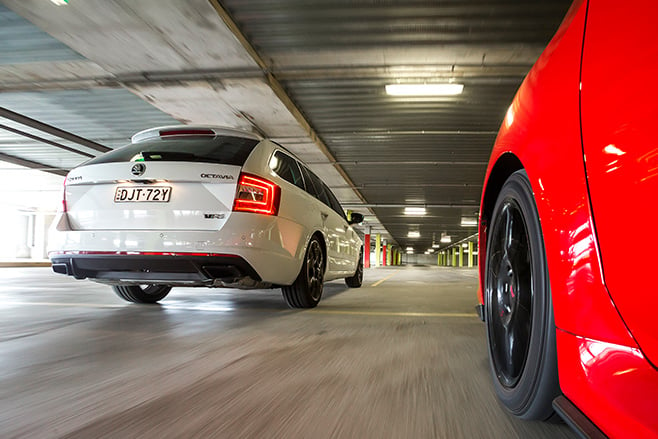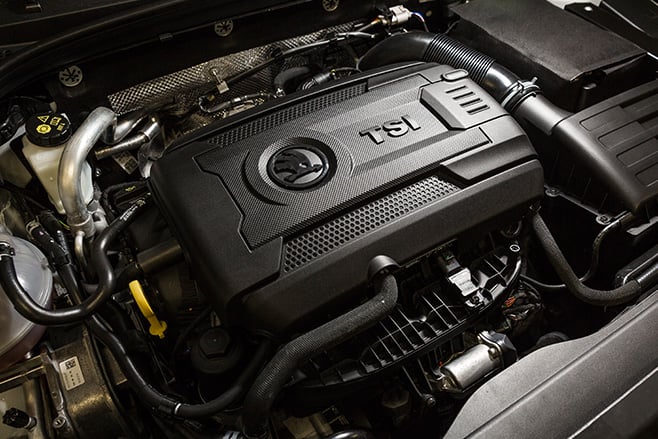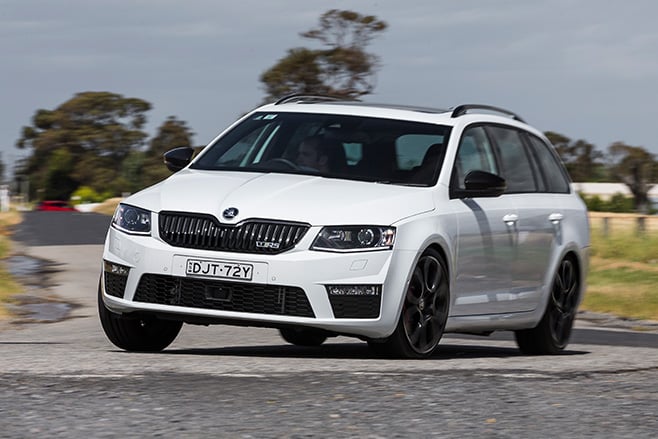The performance wagon is an endangered species. Despite being the perfect car for many needs, it’s under significant pressure from a fast SUV onslaught that threatens to overwhelm the marketplace.
Thankfully, small pockets of resistance remain, for buyers who prioritise performance, dynamics, value and efficiency over a lofty driving position and adherence to the latest trend.
A mainstay in this segment is the Skoda Octavia RS, its combination of proven German mechanicals and Eastern European modesty, not to mention value for money, making it a surprise hit. It appears Aussies prefer their Skodas on the spicy side, too, with the RS accounting for 40 per cent of Octavia sales, more than any other variant.

The result is 169kW/350Nm from the 2.0-litre turbocharged four-cylinder, fed to the front wheels through a six-speed manual and mechanical limited-slip differential. No XDL electronic trickery here, and no lurchy dual-clutch ’box, either.
There’s also a fairly staggering amount of standard equipment. For $43,190 in wagon form (the sedan is $2000 cheaper) the RS230 offers active cruise control, heated front and rear seats, dual-zone climate control, panoramic sunroof, sat-nav and support for Apple CarPlay and Android Auto, a feature Ferrari charges $6790 for in a 488.

You can see where dollars have been saved in the interior as there’s a lot of hard, scratchy plastic, however everything you interact with feels quality and the seats look very cool in a retro ’80s supercar kind of way, though they could use more lateral support. The boot is a spacious 588 litres with the rear seats up and roomy 1718L with them down, though unfortunately the rear seats don’t fold flat.
Nonetheless, it’s a more practical load space than that of the new Subaru Levorg, which offers 522L with the seats up and 1446L with them down, though the rear seats do fold almost flat. Three grades of Levorg are offered, from the $42,990 GT to the $52,890 GT-S Spec B.

For the purposes of our comparison, however, we’ve used the mid-spec $48,890 GT-S as it’s the best match for the Skoda equipment-wise, including features such as a sunroof, auto wipers and headlights, electric heated front leather seats, sat-nav and Subaru’s Vision Assist active safety system, all of which are missing in the more price-competitive base GT.
Material quality is superior in the Subaru, with blue-stitched leather where you’d find hard plastic in the Skoda, and the latest infotainment system is a big improvement over the old unit that still serves in various Toyotas.

The Subaru’s pre-collision alert is hyperactively sensitive, constantly triggering at objects that pose no threat, immediate or otherwise. Likewise, the Skoda’s lane-keep assist constantly nudges the steering; the adjustments are subtle, but eventually you’ll notice the steering feels weird and given the system won’t actually complete a corner for you, what’s the point?
Thankfully for those who actually pay attention while driving, both systems can be deactivated.

The best the RS230 can manage is 0-100km/h in 6.96sec and a 15.03sec quarter mile at 160.68km/h; this more or less matches Skoda’s 6.9sec 0-100km/h claim, however it’s miles off our best of 6.30sec and 14.60sec in a regular manual RS sedan.
From memory, that car allowed the traction control to be deactivated completely, so a new software update could be to blame.

In reality, the two are almost identical in pace, recording very similar trap speeds and separated by just 0.03sec to 160km/h, but the Subaru’s traction gives it a crucial advantage against the clock.
Most enthusiasts instinctively, and rightly, recoil in horror at any mention of the word CVT, but the Levorg’s transmission isn’t the impediment to enjoyment you might expect. There’s a substantial hesitation from rest, however, unless you’re really trying to fire off the line it’s not a huge problem and the take-up is at least smooth.

Unfortunately, the engine it’s attached to is quite uninspiring. We’re not fond of the FA20 engine in the WRX and its installation in the Levorg does nothing to change that view. The CVT disguises the somewhat lumpy power curve found in the manual WRX well and there’s plenty of power available, but while the engine will rev past its 6500rpm redline the strong focus on mid-range torque makes doing so largely redundant.
There’s also precious little in the way of aural character. The raucous boxer burble of old might not be appropriate in the more sensible Levorg, but the baleful whine emitted by the FA20 under heavy load discourages enthusiastic driving, suggesting it would rather you calmed down and stopped accelerating so hard. Effective, but not especially exciting, sums up the Levorg’s drivetrain.

There is a small degree of turbo lag but the mid-range is very strong; however, slightly frustratingly, this then fails to materialise into anything worthwhile at the top end.
It’s a shame Skoda didn’t manage to secure the Golf GTI 40 Years engine for the limited-edition RS230, as in 195kW tune the EA888 is much more aggressive in character with a hunger for revs, and any fears the extra power would overwhelm the Skoda’s chassis are dispelled by the fact the two variants produce an identical 350Nm of torque – the Golf’s extra urge is all at the top end.

It’s a small complaint, however, as the RS230 feels to have the perfect amount of grunt for its chassis. There’s a degree of torque steer on bumpy roads and clumsy throttle inputs can induce wheelspin exiting tight corners, but in general traction is strong. Turbo front-drivers these days often have too much torque to effectively harness without electronic intervention, but the Skoda’s combination of a limited-slip diff and 225/40 R19 Pirelli P Zero rubber proves formidable.
The Skoda’s suspension setup is relatively soft; it lacks Volkswagen’s DCC adaptive dampers, but the tune feels to be roughly halfway between the Normal and Sport modes. This might cost it a few tenths around a racetrack compared to a stiffer setup, but it’s spot on for road use.

This slight softness occasionally becomes apparent at the limit, most notably through large compressions taken at speed or during quick changes of direction where the RS230 can feel a little ponderous. In general, though, it works in the Skoda’s favour, the suspension soaking up bumps rather than allowing them to deflect the car’s trajectory and the increased body movement makes it more involving. The rear can be bought into play slightly, but ESP Sport isn’t lenient enough to let it wander too far.
The brakes are slightly over-assisted around town, but when you dig into them on a twisty road they provide great feel and plenty of staying power. It’s easy to heel-and-toe as well. About the only real dynamic criticism of the RS230 involves the steering.

In contrast, the Levorg needs to be sent straight to the principal’s office. It’s difficult to know where to begin with a chassis that feels so ill-resolved and under-developed. How a team of engineers could spend what was presumably a lot of time, effort and money and have the end result be so compromised is hard to comprehend, especially for a brand like Subaru that trades on its sporting heritage.
The conservative calibration of the ESP system raises the suspicion that Subaru knows the Levorg’s suspension isn’t up to par. Even when switched ‘off’ it’s constantly intervening in an effort to keep everything shipshape, probably because on a bumpy road the wheels feel to spend as much time in the air as on the road.

Thanks to Subaru’s symmetrical all-wheel drive system the Levorg feels quite secure on the road, but it pitches and rolls and wallows under lateral or longitudinal load which can make placing it accurately difficult, particularly when the horribly light arcade-game steering offers next to no connection to the front end. At least it’s not blighted by the persistent rack rattle that afflicts the STI.
To be honest the difference in outright pace between the two cars probably isn’t much, but the experience each offers is worlds apart. The Skoda rewards the keen driver, whereas the Subaru feels so at sea approaching its limits that the driver is effectively discouraged from trying.

This is the most one-sided comparison in recent memory. It’s almost impossible to think of a scenario in which to recommend a Levorg. If you really want a Subaru and you’re not concerned with outright performance, save yourself $20,000 and buy the new Impreza hatch, and if you are, buy a WRX.
And if you need more practicality, the Forester XT is superior to the Levorg in every aspect bar outright performance.

The Octavia RS230 is a truly excellent car; engaging to drive, immensely practical and brilliant value. In outright ability it probably sits between four and four-and-a-half stars, however, we’re inclined to round up on this occasion to reward Skoda’s bravery in importing this manual-only niche model. The performance wagon may be an endangered species, but it’s the strong who survive.







